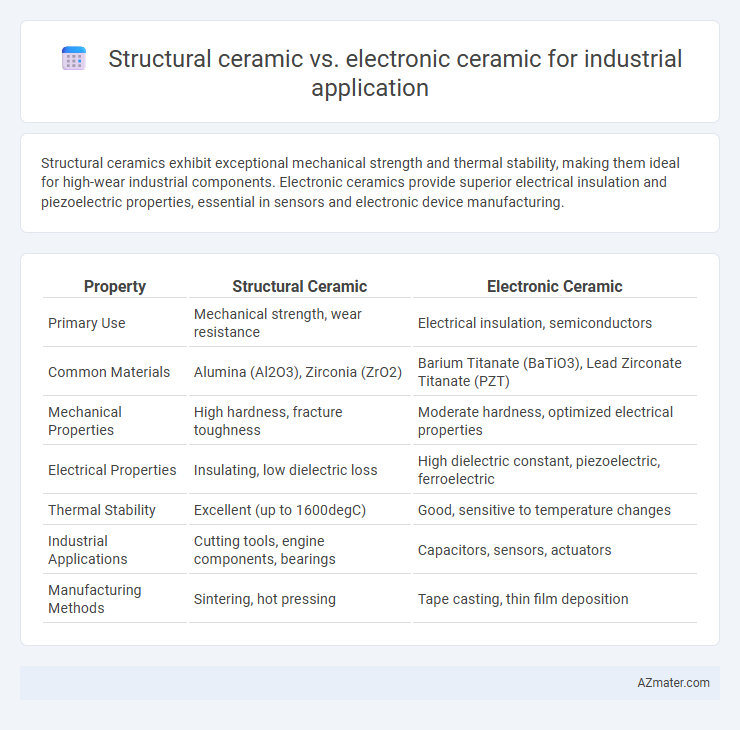Structural ceramics exhibit exceptional mechanical strength and thermal stability, making them ideal for high-wear industrial components. Electronic ceramics provide superior electrical insulation and piezoelectric properties, essential in sensors and electronic device manufacturing.
Table of Comparison
| Property | Structural Ceramic | Electronic Ceramic |
|---|---|---|
| Primary Use | Mechanical strength, wear resistance | Electrical insulation, semiconductors |
| Common Materials | Alumina (Al2O3), Zirconia (ZrO2) | Barium Titanate (BaTiO3), Lead Zirconate Titanate (PZT) |
| Mechanical Properties | High hardness, fracture toughness | Moderate hardness, optimized electrical properties |
| Electrical Properties | Insulating, low dielectric loss | High dielectric constant, piezoelectric, ferroelectric |
| Thermal Stability | Excellent (up to 1600degC) | Good, sensitive to temperature changes |
| Industrial Applications | Cutting tools, engine components, bearings | Capacitors, sensors, actuators |
| Manufacturing Methods | Sintering, hot pressing | Tape casting, thin film deposition |
Introduction to Industrial Ceramics
Industrial ceramics encompass a broad range of materials tailored for specific applications, divided mainly into structural ceramics and electronic ceramics. Structural ceramics, such as alumina and silicon carbide, are prized for their exceptional mechanical strength, wear resistance, and thermal stability in harsh environments. Electronic ceramics, including barium titanate and zirconia, provide critical functions like dielectric properties, piezoelectricity, and conductivity, essential for sensors, capacitors, and other electronic components in industrial settings.
Defining Structural Ceramics
Structural ceramics are advanced materials engineered for mechanical strength, wear resistance, and thermal stability in demanding industrial applications such as cutting tools, engine components, and armor. Unlike electronic ceramics, which prioritize electrical conductivity, dielectric properties, or piezoelectricity for use in sensors, capacitors, and insulators, structural ceramics are optimized for load-bearing and harsh environmental resistance. Key materials like alumina, silicon carbide, and zirconia exemplify structural ceramics, offering superior hardness and fracture toughness essential for manufacturing and energy sectors.
Overview of Electronic Ceramics
Electronic ceramics, also known as functional ceramics, are engineered materials designed to possess specific electrical, magnetic, or optical properties essential for industrial applications such as capacitors, insulators, and sensors. Unlike structural ceramics, which prioritize mechanical strength and wear resistance, electronic ceramics focus on dielectric constant, piezoelectricity, and ferroelectric behavior to optimize performance in electronic devices. These materials often include compositions like barium titanate, zirconia, and ferrites, offering high reliability and efficiency in harsh operating environments.
Material Composition and Properties
Structural ceramics in industrial applications primarily consist of alumina (Al2O3), silicon carbide (SiC), and zirconia (ZrO2), offering high mechanical strength, wear resistance, and thermal stability essential for load-bearing components. Electronic ceramics, such as barium titanate (BaTiO3) and lead zirconate titanate (PZT), exhibit dielectric, piezoelectric, and ferroelectric properties, making them ideal for sensors, capacitors, and actuators in industrial electronics. The distinct material compositions influence their performance, with structural ceramics optimizing toughness and hardness, while electronic ceramics focus on electrical conductivity and dielectric behavior.
Key Performance Characteristics
Structural ceramics exhibit high mechanical strength, excellent wear resistance, and superior thermal stability, making them ideal for demanding industrial environments requiring durability under mechanical stress. Electronic ceramics offer exceptional electrical insulation, dielectric properties, and thermal conductivity, crucial for applications in sensors, capacitors, and electronic substrates. Both types optimize industrial performance by addressing specific operational challenges: structural ceramics handle mechanical loads and harsh conditions, while electronic ceramics ensure reliable electrical performance and signal integrity.
Common Industrial Applications
Structural ceramics find widespread use in industrial applications requiring high mechanical strength, wear resistance, and thermal stability, such as cutting tools, engine components, and armor materials. Electronic ceramics are essential in industries for their dielectric, piezoelectric, and semiconductor properties, enabling applications like capacitors, sensors, and insulating substrates. Both types of ceramics contribute to improved efficiency and durability in industrial equipment, with structural ceramics providing physical robustness and electronic ceramics enhancing electrical functionality.
Mechanical Strength vs Electrical Functionality
Structural ceramics offer exceptional mechanical strength, high hardness, and excellent thermal stability, making them ideal for demanding industrial applications like cutting tools, wear-resistant components, and engine parts. Electronic ceramics are engineered for electrical functionality, including high dielectric constants, piezoelectricity, and semiconducting properties, which are critical for sensors, capacitors, and insulating substrates. The choice between structural and electronic ceramics depends on prioritizing mechanical durability versus electrical performance in industrial environments.
Advantages and Limitations
Structural ceramics offer exceptional mechanical strength, high wear resistance, and thermal stability, making them ideal for demanding industrial applications such as cutting tools and engine components. Electronic ceramics provide superior electrical insulation, piezoelectric properties, and dielectric capabilities, crucial for sensors, capacitors, and semiconductors. Structural ceramics face limitations in electrical conductivity and brittleness, while electronic ceramics are constrained by mechanical strength and thermal shock resistance.
Selection Criteria for Industrial Use
Structural ceramics are selected for industrial applications based on their mechanical strength, hardness, wear resistance, and ability to withstand high temperatures and corrosive environments. Electronic ceramics are chosen for their dielectric properties, electrical conductivity, piezoelectricity, and thermal stability essential for components like capacitors, sensors, and insulators. Selection criteria prioritize mechanical robustness and thermal resistance for structural ceramics, while electronic ceramics require precise control over electrical and dielectric characteristics to optimize device performance.
Future Trends in Industrial Ceramic Technologies
Structural ceramics offer exceptional mechanical strength, wear resistance, and thermal stability, making them ideal for heavy-duty industrial applications such as cutting tools and engine components. Electronic ceramics are advancing rapidly with innovations in piezoelectric, dielectric, and semiconductor properties, enabling improvements in sensors, actuators, and energy storage devices. Future trends emphasize the integration of nanotechnology and additive manufacturing to develop multifunctional ceramics that combine high performance with customization for Industry 4.0 demands.

Infographic: Structural ceramic vs Electronic ceramic for Industrial application
 azmater.com
azmater.com